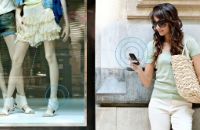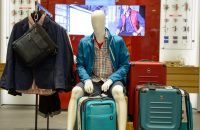Personalizing Shopping: How An ERP System Can Tailor Your Customer’s Experience
 A Data Drive Approach
A Data Drive Approach
In today’s world of technological convenience, retail customers don’t just want to shop for products; they want to feel like they’re giving their hard-earned money to store owners who value them. It’s becoming increasingly difficult for retailers to keep up with their customers and to provide them with the best possible service at every touch point.
How can a retailer sell more products, provide a personalized brand experience for each customer, AND build loyalty? Numbers speak louder than words, and the way to get them talking is with the help of an Enterprise Resource Planning (ERP) system.
An ERP management information system integrates planning, purchasing, sales, marketing, inventory, finance, and more, and replaces best-of-breed systems that cause gaps in information silos. With an ERP, a company can collect, store, manage and interpret data across the chain and find efficient ways of growing.
With such data at your fingertips, there’s no limit to the ways that you can impress your customers. Here are three ways an ERP solution can tailor your customer’s shopping experience and sell, sell, sell.
1- Product Messaging Consistency
No matter what brand story is being relayed to customers, an ERP system can keep it consistent at every customer touch point.
Let’s look at a case scenario.
A customer is at an aquarium supplies store shopping for a fish tank pump. The retailer of that store wants to convey to the customer what other tank accessories complement the pump. In the past, retailers often missed opportunities to cross-sell because knowledge about what accessories go with what products varied from clerk to clerk.
Option A:
With a centralized database in place, product information can be dispatched to the customer before they even reach the register. Using branded messages throughout the store, retailers can encourage all customers to scan the product’s bar code using their mobile device or a nearby scanning station to uncover product details not marked on the packaging.
Option B:
If the customer reaches the register and has not picked up any accessories which complement the pump, the store cashier can provide this service by suggesting in-stock accessories based on the suggestions provided by the Point-of-Sale.
If the customer wishes to buy the additional products, the store clerk can suspend the transaction while the customer or a store associate retrieves the items.
If the product is not in the store, the store clerk can even determine the nearest location of the items and offer to have them shipped to the customer’s home.
Option C:
For returning customers, the POS can bring up all past transactions and can suggest new products in stock that complement items that the customer has at home. The store clerk can also offer a discount to returning customers or collect points by scanning loyalty cards.
Even if the customer is not interested in purchasing any accessories, the story the retailer told the customer was consistent throughout the entire process: ‘trust us to provide you with an easy, informative, and efficient shopping process.’
2- Clearing Up Price Confusion
Price confusion is a pain point which too often puts customers and retailers against one another.
Put yourself in the customer’s shoes.
A customer comes into a store after hearing about an advertised or promotional price for an item, they select the product and head to the cash register when, much to their frustration, they discover the product is not marked as advertised.
What happens next?
Since the pricing strategy was not clearly carried out across all channels, often the cashier is left to solve the pricing discrepancy, creating a breakdown in customer loyalty as the customer and everyone next in line must wait for the problem to be solved.
Price confusion is a major problem for all multi-channel retailers, but for JCPenney it was a nightmare. The entire organization felt the pain of price discrepancies so severely that the chain recently eliminated individual promotions altogether.
In February 2012, JCPenney suspended their weekly coupons, discounted merchandise and slashed prices for an “everyday low price” guarantee strategy.
Unfortunately, JCPenney’s everyday low prices strategy isn’t one-size-fits-all solution. Customers don’t always make price-conscious choices; sometimes they choose a retail store because it offers the best buying experience.
Fortunately, ERP solutions are making it possible for retailers to offer customer-specific pricing using highly accurate data before the customer reaches the register. Now, weekly promotional activities can run more efficiently and profitably.
3- Reward Your Regulars
More and more customers want to feel appreciated and recognized for their loyalties, but without the right technological solutions, store clerks are often left to deduce sales opportunities without access to the customer’s entire purchase history – a difficult challenge.
To provide real value to customers more consistently, retailers are looking to ERP solutions as a way to recognize their regular clients’ buying habits and reward them for being great customers. Once their driver’s license has been scanned (either through a mobile device or standard POS system), customers’ information is stored in a centralized ERP database that can be accessed throughout the organization’s channels. Store managers or the corporate office can create and manage promotions personalized to a customer’s unique purchasing habits.
With an ERP system in place, a store associate can also build the ideal shopping experience for the customer in seconds using prompts from the computer system upon checkout.
For example, if a loyal customer is checking out at a wine retailer, the store clerk might notify a customer that one of their popular wines is coming into stock. To sweeten the deal, the clerk might offer the customer a special price to pre-order a case in advance.
Without an ERP system in place, the clerk wouldn’t be able to cross reference the customer’s purchase history with the wine futures coming into stock. It’s opportunities like these that make ERP solutions integrated with POS so lucrative for retailers. They empower the retailer to increase the bottom line while increasing satisfaction for an already loyal customer.
Times Have Changed
Thirty years ago, the average retail customer was a different animal than today. The Internet was just a twinkle in a computer programmer’s eye; people mostly limited themselves to the products that they could find locally.
Today, customers can compare product prices, read product reviews, and order at the click of a mobile phone. Despite these technological conveniences, people continue to shop retail.
Why?
People still desire a personalized, tangible shopping experience. ERP solutions can help retailers provide it.
Want to read this later? Click to download the guide as a PDF.
*no email registration required
RECENT POSTS
 A Quick Guide: How to Adapt to Change & Thrive During the Pandemic as a Liquor ChainDownload this guide to learn the three ways an [...]
A Quick Guide: How to Adapt to Change & Thrive During the Pandemic as a Liquor ChainDownload this guide to learn the three ways an [...] How to Get Started with Omnichannel for RetailOmni-channel is the new stage of building customer relationships [...]
How to Get Started with Omnichannel for RetailOmni-channel is the new stage of building customer relationships [...] Guide: Merchandising Optimization and Strategy for Midsized RetailersThis white paper examines how top retailers are improving [...]
Guide: Merchandising Optimization and Strategy for Midsized RetailersThis white paper examines how top retailers are improving [...]
